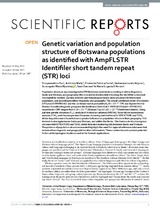Genetic variation and population structure of Botswana populations as identified with AmpFLSTR Identifiler short tandem repeat (STR) loci
Date
2017-07-28Author
Tau, Tiroyamodim
Wally, Anthony
Fanie, Thokozile Patricia
Ngono, Goitseone Lorato
Mpoloka, Sununguko Wata
Davison, Sean
D’Amato, María Eugenia
Metadata
Show full item recordAbstract
Population structure was investigated in 990 Botswana individuals according to ethno-linguistics, Bantu and Khoisan, and geography (the nine administrative districts) using the Identifiler autosomal microsatellite markers. Genetic diversity and forensic parameters were calculated for the overall population, and according to ethno-linguistics and geography. The overall combined power of exclusion (CPE) was 0.9999965412 and the combined match probability 6,28 × 10−19. CPE was highest for the Khoisan Tuu ethnolinguistic group and the Northeast District at 0.9999582029 and 0.9999922652 respectively. CMP ranged from 6.28 × 10−19 (Khoisan Tuu) to 1,02 × 10−18 (Northwest district). Using pairwise genetic distances (FST), analysis of molecular variance (AMOVA), factorial correspondence analysis (FCA), and the unsupervised Bayesian clustering method found in STRUCTURE and TESS, ethno-linguistics were found to have a greater influence on population structure than geography. FCA showed clustering between Bantu and Khoisan, and within the Bantu. This Bantu sub-structuring was not seen with STRUCTURE and TESS, which detected clustering only between Bantu and Khoisan. The patterns of population structure revealed highlight the need for regional reference databases that include ethno-linguistic and geographic location information. These markers have important potential for bio-anthropological studies as well as for forensic applications.

